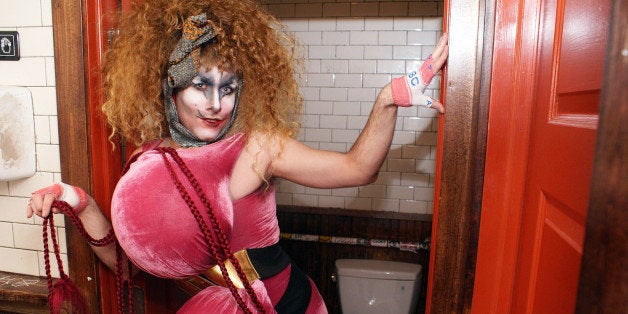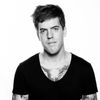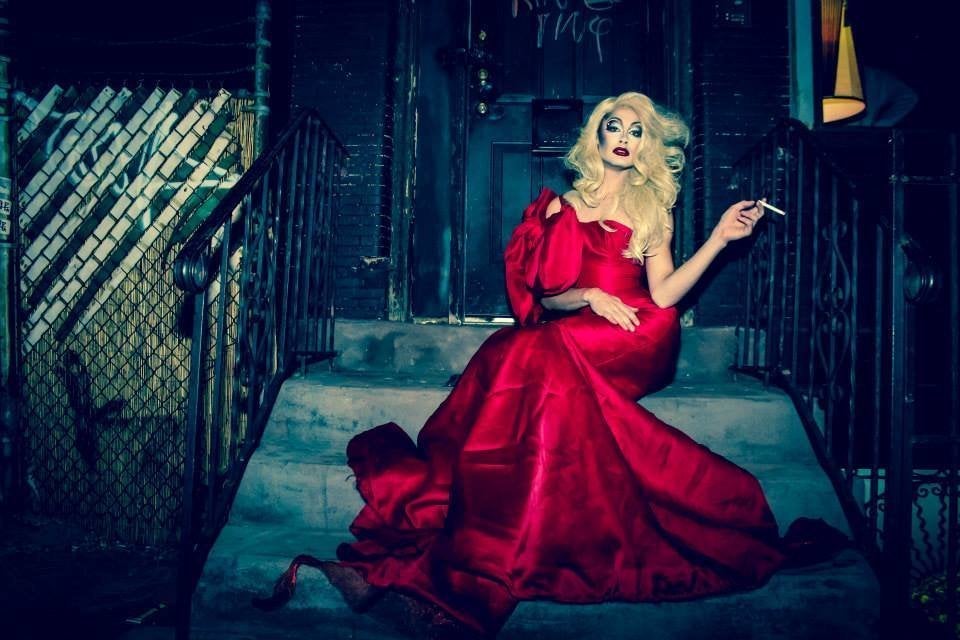
This is the thirteenth installment in an ongoing series that explores drag culture and the nightlife scene in Brooklyn, N.Y. Over the past several years, following the large-scale exodus of artists across the East River and into northern Brooklyn, those engaged in drag culture in this outer borough have created a new, queer world entirely their own. Accompanied by a larger movement to understand drag culture outside of the pageant circuit, many individuals engaged in the drag community in this borough approach drag culture through a nontraditional lens of "alternative" drag or performance art, enabled largely by the malleable and queer nature of this part of New York. Visit HuffPost Gay Voices regularly to learn not only about the individuals involved in Brooklyn's drag community, but more about the culture of the community itself.
The Huffington Post: How did you get your start in the drag world?
Chris of Hur: Chris of Hur was born last April at Hot Fruit at [Brooklyn gay bar] Metropolitan, run by my friend David John Sokolowski who was gracious enough to let me get up there without knowing what I was going to do. That night Merrie Cherry was in the audience and apparently she liked what she saw because she started booking me for events. After that things just kind of snowballed.
Before Chris of Hur, though, I had been performing in drag off and on for years, but mostly at art openings and various straight/mixed hipster shindigs. It was successful but didn’t really go anywhere. I was doing pretty much exactly what I’m doing now but there wasn’t really the right supporting culture for it to build upon. Then I found what was going on in Brooklyn (with drag artists like Krystal Something Something, Raul de Nieves, Colin Self, Gage of the Boone, Hamm Samwich, etc.) and it kind of felt like recognizing a long lost family member I hadn’t met and wasn’t even sure existed. It didn’t happen like a lightning bolt but definitely in a short amount of time I realized “oh yeah, here.”
What does it mean to you to be a drag performer? How do you experience or understand this identity?
I like the word drag, but I’m not sure I would ever call myself a drag queen (I don’t mind if someone else does though). Even drag performer feels too general. I’ve recently started calling myself a "draggle," though we’ll have to see how long that sticks. I do feel a certain kinship with Marjory the Trash Heap of "Fraggle Rock" and many people already refer to me as a muppet. So I think it fits for now.
In what way would you say that the drag scene in Brooklyn points to the direction that drag is going?
Brooklyn is New York. New York, even if it doesn’t do it better, will always do it bigger and work harder at it. Like it or not, New York is still the center of everything cultural.
In Brooklyn, I see a culture that’s picking up where the queerdos of the '90s left off. Queer nightlife was a little too uptight, moneyed and velvet roped in the 2000s. Now I feel like the craziness is back in New York and Brooklyn is just where it’s happening because Manhattan is too expensive (and the revolution only likes to be in one borough at a time – sorry Queens!). When I look around I see so many artistic descendants of Lou Reed, Claude Cahun, Lucas Samaras, Jayne County, The Divine David, Jack Smith, The Cockettes, Miss Guy, and countless other legendary gender pushers. What I think is coming through the most in Brooklyn drag culture from the overall arc of drag history is the desire to pull apart, rearrange, experiment and distort ideas of gender.
It’s like with painting, once we achieved realism as far as it could go (and still be interesting) we started playing with form and application.
With drag, how much more realism do you need than Craig Russell and Jimmy James? They perfected male-female transformation while still remaining “drag." While I think there is certainly a love and appreciation for bio-impersonation drag within the culture of Brooklyn, it’s very much in the background. Most of us are working out ideas that, whether we realize it or not, are much bigger than that. In fact, I think what’s happening in Brooklyn is actually very much a logical product of the modern state of humans -– we no longer have a need for the same gender roles we have spent the past 100,000 plus years evolving into. In fact, they are starting to drag us down (no pun intended) -- they are keeping us as a species from fulfilling our potential.
(The interview with Chris of Hur continues after the slideshow.)
How would you characterize the kind of drag that you do?
I’m just doing what I like, so perhaps I’m not the best person to characterize it, since I’m not really thinking that much about it. However, I suppose something I am conscious of is that I do try to create a symbol-free setting. I rarely do anything narrative and never make cultural references, at least not without abstracting it into mush or pushing it in multiple directions. I’m more into how we communicate and create symbols rather than the particulars of what we are talking about. I love how objects/words/ideas not only mean different things to different people, but they can also have multiple “official” meanings.
Most every word in the dictionary is presented with a list of definitions. Every flag, every seal, every foundation is usually built on more than one principle. Virtually everything we use to say something contains not only nuance but also multiplicities. I think drag is great for exploring that because it starts out by communicating both male and female, which then spirals into “masculine” and “feminine,” and that ultimately an invented bi-section -- like “Democrat” and “Republican” -– it’s constantly evolving and overall it contains as much baggage as it does substance. In my head, my ideal is to create something that balances a known dichotomy and then flood it with a bunch of stuff that doesn’t fit within it. It’s actually a fairly simple recipe I use -- feel free to try it at home: one part that, one part the opposite of that, and ten parts this shit that’s nothing like any of that.
Do you feel as if the rapidly changing nature of Brooklyn itself has opened up a unique space for queer artists and drag culture?
As I mentioned before, Manhattan has gotten too expensive, in fact too expensive for it’s own good -– not that I really care. We have enough out here that’s more fun anyway. I almost never go out in Manhattan anymore (unless I’m booked for a gig). Why would I? The drinks are twice as much and the bars are overcrowded. Plus to take the train is $5 roundtrip, if not $30-60 for a cab. No, thank you. It’s a shame though, I have several good friends in Hells Kitchen… I haven’t seen them in ages!
Out here we are able to create our own world which I think is what any creative community needs to flourish. The rules feel more relaxed and our paychecks go further, so we are just able to be a little more fun and fancy free. Plus we have more space. I have a theory that if you can’t find a spot near where you live that you can put your arms straight out and start spinning without hitting something or someone, you are simply not living in an area that is capable of harboring a truly vibrant art community.
Do you find empowerment through drag?
Anytime you do something that others are unwilling or unable to do it’s empowering. It can also be alienating, but I’m kind of an alien and at the end of the day I like being an alien.
Where can you be found throughout the week?
Well, my only regular gig is a monthly event called Ritual at Tandem (every third Tuesday), which is run by my friend Manifestany Squirtz. But I perform around twice a week at one place or another, Metropolitan (usually Hot Fruit on Monday or Two in the Bush on Wednesday), Bizarre (usually White Diamonds – although it’s a party that’s more about looks than performances), Wreck Room (I seem to be Lady Simon’s unofficial understudy at Bless This Mess, Thursdays), The Spectrum (either at Dizzyland or just in general at 4am twirling around drunkenly in an elaborate outfit that no one can see because it’s too dark), etc. Really, if it’s a party or a bar in Brooklyn and they let drag things perform, then I’ve either performed there or I’m about to perform there. Also, I’ve been getting a bunch of gigs recently in Manhattan, so watch out for me there (below 14th street, let’s be realistic). Keep up to date on my Facebook.
Any parting words?
Thank you for not bringing up "Drag Race."
Missed the previously featured drag performers and installments in this series? Check out the slideshow below.


